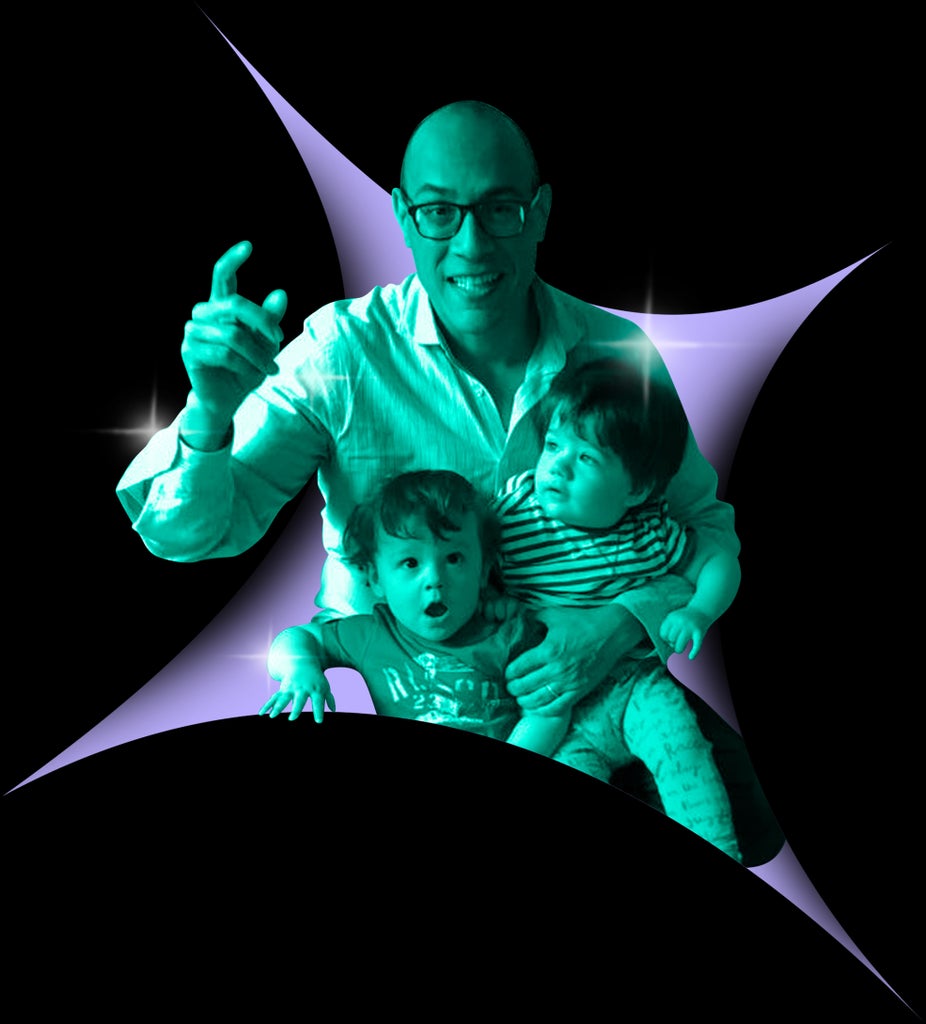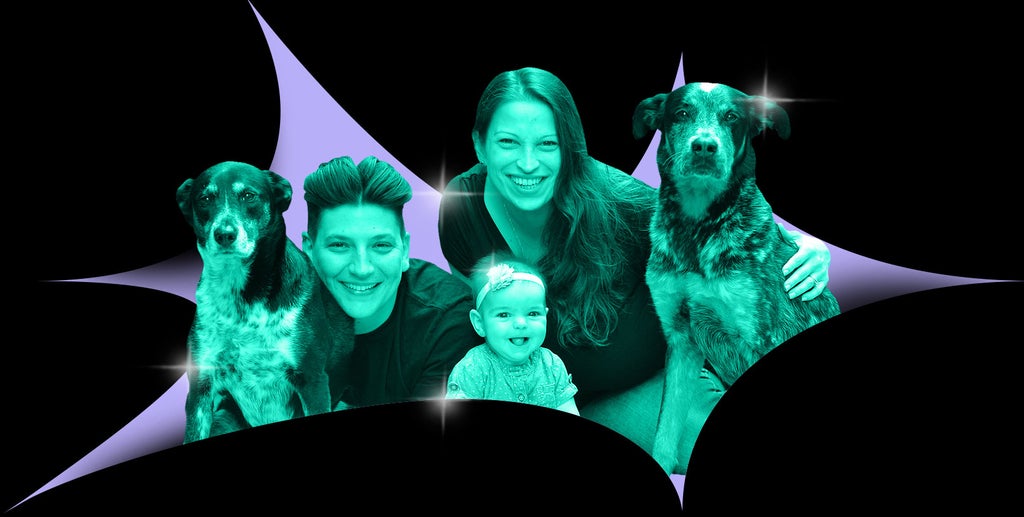Jac Ciardella sat at his kitchen table in New Jersey and inserted a syringe into a navel orange. His hand flexed as he squeezed the plunger, pushing water into the fruit’s rind. He needed the practice. He was about to inject fertility drugs into his wife, Candice Ciardella, and he wanted to get it exactly right. He knew how painful it could be.
Just a year earlier, in February, 2017, the spouses’ positions were swapped: Candice, now 37, was administering the shot for Jac, who’s 40. Jac is a transgender man, and both he and his wife have undergone in vitro fertilization (IVF) in order to have a child.
The couple’s fertility journey started in 2015. The original plan had been to use donor sperm to impregnate Candice. But after six unsuccessful attempts at intrauterine insemination (IUI), they decided to try IVF on Jac, with the idea that Candice could carry one of his fertilized eggs. Candice began giving her husband shots of the hormone human chorionic gonadotropin (hCG), to make him produce extra eggs.
“For years, needles were just part of the routine for us,” Candice says. “I think we had more empathy for one another because we both knew what it felt like. When it comes to the shots and the appointments, not many spouses can say: ‘I know exactly what you’re going through.’ We can.”
The process was emotionally taxing for both of them, but especially for Jac. “Someone’s head is between your legs, and it’s awkward for anyone — but, being transgender, it’s extra awkward,” Jac says. “Mentally, I’m feeling like I’m not supposed to be in that position. For me to feel comfortable going through IVF while still keeping my sanity and my integrity was huge.”
Three cycles of IVF weren’t successful, and testing revealed no clear issues that would cause infertility. So in 2018, the Ciardellas decided to try IVF again, on Candice this time.
“It was emotionally defeating. If you can survive IVF and infertility, your marriage should be able to survive just about anything else,” Jac says. “It’s humbling and debilitating and cruel.” Adding to their stress was the financial strain. The Ciardellas were acutely aware that each failed cycle of IVF and IUI was costing them — big time. “You’re talking about tens of thousands of dollars going out the door,” he says. “It takes toughness.”
Jac and Candice’s story is unique, but the financial burden they faced is not. Most LGBTQ+ couples who want children have to confront the fact that starting a family will be expensive. Adoption, fertility treatments, and surrogates are all costly, often lengthy processes.
The Ciardellas say their insurance only covered their testing for issues that could cause infertility, such as blocked fallopian tubes. They had no financial help with the sperm, the IUIs, or the rounds of IVF. All told, over the course of three years, the couple would spend about $120,000 on four IVF cycles, $20,000 on fertility drugs, plus over $10,000 on IUI. “I got those numbers imprinted on my brain,” Jac says. “We always knew that to be parents, we’d need to be cutting into a good chunk of change — but we didn’t expect it to be quite that much.”
Sandy Chuan, MD, a fertility specialist at San Diego Fertility Center, confirms that the costs of conceiving via fertility treatments can be shockingly high for LGBTQ+ couples.
She says sperm samples can cost $600 to $900 per vial. One IUI attempt without insurance costs about $700 to $1,000, plus the donor sperm. “I usually tell my clients to ballpark around $1,500, but they might need to do three to six rounds,” Dr. Chuan explains. If IUI is unsuccessful, the next step is IVF, which Dr. Chuan says can cost as much as $15,000, plus $4,000 to $5,000 for medications to stimulate egg production. The price point for procedures can vary by state and market.
For couples who need a donor egg, a process that requires IVF, the price can be around $25,000 to $30,000, which includes the creation of embryos and the donor’s medical screening. Compensation for the egg donor, genetic testing, legal fees, and medication may add on an additional $6,000 to $20,000.
If a couple is using a surrogate, which is only legal in some states, costs climb to an average of $110,000, according to the FertilityIQ, an organization that researches fertility treatments and their costs. Dr. Chuan tells her patients to budget for $150,000 to account for miscellaneous expenses. “I would estimate $120,000 to $180,000 for patients, and they should realize that medical fees are just a part of that number,” she says. “After that you’re paying for things like for medications and compensation for the egg donor and surrogate, legal fees, and agency fees.” You may also need to pay for your surrogate’s insurance fees, and compensate them for time off work if they’re put on bedrest.
Then there are the dozens of smaller costs that add up over a process that can sometimes take years: psychological evaluations for yourself and possible surrogates, as well as travel expenses, to name a few.
 |
“It wasn’t like going to Barney’s and getting one big bill at the end,” says David Kaufman, a journalist in New York City. It was just three and a half years ago that Kaufman had twins via surrogacy with his husband. At the time, he was continually surprised by the costs that cropped up, including trips out of state to visit their surrogate (until this year, paid surrogacy was largely illegal in New York) and hospital bills that kept rolling in after his sons, Aaron and Luca, were born.
Many couples, hoping to defray the costs of fertility treatments or adoption, wind up turning to grants, fertility loans, or even GoFundMe pages.
Ashley Valenzuela, a 34-year-old kindergarten reading interventionist in Colorado, always knew she wanted to have a baby with her wife, 38-year-old Tina Valenzuela. “We joked when we got married that we didn’t really need any gifts, we just wanted money to help with our baby fund.”
After Ashley underwent five unsuccessful attempts at IUI, costing the couple $15,000, she was diagnosed with polycystic ovary syndrome (PCOS) — a hormonal condition that is a common cause of fertility struggles — and was told her best option was IVF. But she didn’t have the money. Then the couple found Baby Quest, a nonprofit organization that offers about 20 grants a year to pay for people’s fertility treatments. Ashley and Tina applied twice, and were eventually awarded a grant for about $15,000 to put towards IVF and the associated medications.
However, “I’m sure we spent at least another $15,000 on IVF on top of the grant,” Ashley says. “In total, counting the IUIs, about $45,000.” They had to pay for extra medications, genetic testing, and surgery related to her PCOS. They picked up side gigs to cover the cost. They started doing reflexology and reiki out of their home office. Ashley worked at Panera Bread in the summers; Tina, a small business owner, drove Lyft. They’re now seven months pregnant.

“Are people not having babies because of the cost?” asks Andrea Braverman, PhD, a fertility expert and clinical professor at Thomas Jefferson University. “I would be happy to bet my house on that.”
Adding to the financial burden is the fact that most LGBTQ+ people pay for their fertility treatments out of pocket. “For all these years I’ve been in practice, I’ve only had one patient who had their egg donor cycle covered [by insurance],” Dr. Chuan says. “That’s because the patient’s company offered a $100,000 credit for fertility treatments. The rest of my patients have basically all paid thousands out of pocket.”
About 71% of all U.S. patients undergoing IVF in 2018 had no insurance coverage, according to data from FertilityIQ — a number which didn’t factor in sexuality.
Among the companies that do insure these procedures, the coverage might only apply for proven infertility, which is defined in some policies as a “disease or condition” characterized by the failure to conceive “with regular, unprotected sexual intercourse.” This can be interpreted in a way that excludes coverage for LGBTQ+ people.
RESOLVE: The National Infertility Association has put forward legislation that has changed this definition in some states, such as Colorado, and is working with The National Center for Lesbian Rights (NCLR) and Men Having Babies to ensure the definition is inclusive across the board.
“The key is not to call it a disease or condition,” explains Ron Poole-Day, the founder of Men Having Babies. He prefers a definition drafted by Cathy Sakimura, the family law director of the NCLR. She drafted language that dubs infertility as the “inability to conceive or birth children without medical intervention,” which can be shown, in part, by “a statement that a covered individual plans to conceive a child either as an individual or with a partner with whom the covered individual cannot conceive a child through sexual intercourse.”
We always knew that to be parents, we’d need to be cutting into a good chunk of change — but we didn’t expect it to be quite that much.
Jac Ciardella
“We want to try to remove cost as a barrier to care, and argue that reproduction is a basic human right,” says Betsy Campbell, the chief engagement officer at RESOLVE. “We have the medical care to make that possible, and we think that insurance should cover medically necessary treatments.”
Another example of inequality in coverage: Some insurance policies might make a heterosexual couple prove medical infertility by having unprotected sex for a year with no results. That practice, while frustrating, is free. A lesbian couple, on the other hand, might be asked to show their insurance company they’ve had six unsuccessful attempts at IUI, explains Diane Ravech, vice president of network contracting at CCRM Fertility. They could end up paying around $6,000 or more out of pocket for those procedures alone.
Many people who have struggled to conceive on their own have been asked, “Why don’t you adopt?” But this method is also pricey, explains Nicole Witt, executive director at The Adoption Consultancy, which provides information and resources to those who want to adopt. “For people who are looking to take home a newborn through private, domestic adoption through an agency, the price can run from $30,000 to high $40,000s, minus a federal tax credit of up to $14,300.” The cost of international adoptions are similar, though travel costs may be higher, Witt says.
Fostering is one of the more affordable ways for LGBTQ+ couples to bring children into their lives, Witt says. States give foster families a monthly stipend to support the child, and you can tell an agency up front that you’d eventually like to adopt. If you do adopt a foster child, most fees are waived, save for $1,000 or so in legal fees, which also may be waived, says John DeGarmo, PhD, the founder of The Foster Care Institute.
Fostering to adopt can be a hugely positive experience for both the parents and children involved. It’s not always a straightforward path, though. Since the goal with fostering is typically to reunite the child with their biological family, the process can take at least 18 to 22 months or longer, DeGarmo says. “I’ve adopted three kids from foster care, but I’ve also had four failed adoptions,” he notes.
Another consideration LGBTQ+ people must make is legality. Same-sex couples still aren’t legally allowed to jointly adopt in all countries. The Supreme Court has ruled that same-sex marriages are to be treated equally for all purposes in all 50 U.S. states. But a handful of states have laws that allow religious organizations to turn away LGBTQ+ folks who want to be foster or adoptive parents — in some instances, even if those organizations use government funding, explains Currey Cook, counsel and the director of Lambda Legal’s Youth in Out-of-Home Care Project. “In cases like this, the federal and some state governments are saying that this is fine,” he says. “It’s the government’s contention that there’s no harm to [couples blocked by such laws] because they can go somewhere else.” But the truth is, it’s not that simple.
In 2017, Fatma Marouf, the director of the Immigrant Rights Clinic at Texas A&M School of Law, was contacted by Catholic Charities Fort Worth. The organization hosts immigrant and refugee children until they’re placed with foster parents and receives money via federal grants. After touring the facilities, Fatma came home and gushed about the experience to Bryn Esplin, an assistant professor of medicine.

“I told Bryn that I just thought we could offer these kids a better place,” she says. “I felt bad for them in those facilities. There was no art on the walls.” She thought of the paintings on her walls in her home, and her full bookshelves, which are covered with novels, trinkets, and pictures.
The couple got on the phone with Catholic Charities to explore the possibility of fostering. The organization read off a list of requirements to become foster parents, things like having a fire extinguisher in the house, and having drawer space for the child.
“I was listening to the list, and writing things down,” Bryn says. “Check, check, check. But when they realized we were two women — I think at first they thought my name was Bryan — they added that there was another requirement, that foster parents ‘mirror the holy family.’ I remember writing it down, circling it, and then looking at Fatma just bewildered — in disbelief.”
The phrasing prompted Fatma to clarify that she and Bryn are a same-sex couple. The Catholic Charities representative then told them they didn’t “qualify” to foster a child, according to the criminal complaint.
Bryn and Fatma are now plaintiffs in a lawsuit against the federal government, fighting against the discrimination they faced. They’ve been entangled in the legal system for three years. They’re being represented by Lambda Legal, which works to defend the civil rights of the LGBTQ+ community.
“We know this is discrimination at its core,” explains Jamie Gliksberg, the lawyer representing the case. “It’s known in the LGBTQ+ community, especially in a smaller region of Texas like this, that, due to discrimination, same-sex couples experience countless barriers to fostering and adopting children. As a result, they often have to resort to more expensive options in order to have children and grow their loving families.”
Other parties involved, including Catholic Charities Fort Worth and The United States Conference of Catholic Bishops, didn’t respond to Refinery29’s request for comment. The United States Department of Health & Human Services, The Office of Refugee Resettlement, and The Department of Justice declined to comment on pending litigation.
The case is still ongoing, but Fatma and Bryn have found a silver lining. After going through IVF, the couple welcomed their daughter Azra into the world earlier this year.
Jac and Candice say they tried to get their insurance company to cover their treatments when they were going through their fertility struggles. The war waged with their insurance company was a supremely frustrating part of their journey. At first, they couldn’t tap into their plan’s benefits unless they could prove they struggled with infertility as defined by their insurance company. “They said we didn’t meet their definition for infertility,” Candice says.
In a January 2017 letter denying coverage, UnitedHealthcare Oxford stated: “Infertility is when you cannot become pregnant after at least 6 months of regular unprotected intercourse if you are 35 years of age or older” and “when you cannot become pregnant after at least six months of a doctor supervised donor insemination if you’re 35” or older. Refinery29 obtained a copy of this letter.
Jac found the first part of this definition offensive. “I was like, I’m sorry, but would you like me to just find a random guy and have sex against my wishes and try to get pregnant as a man?” he says now.
After this letter, Jac says the insurance company got in touch, saying he now qualified for fertility treatments medically — but they were still denying coverage because the fertility clinic Jac and Candice had been referred to was out of network. The health insurance company confirmed that decision to Refinery29.
UnitedHealthcare Oxford also told Refinery29: “The couple had not met the criteria for requested coverage in 2016 and did not appeal this decision.” However, in March, 2017, Jac says he sent an appeal letter to UnitedHealthcare Oxford. According to a copy that was obtained by Refinery29, part of that emotional rebuttal reads: “Creating life is one of the most magical and beautiful journeys you can go through and when you are stripped of this ability it is devastating. Just as you are coming to grips with the fact that you will need the help of strangers, needles, and cold, steel equipment to create a beautiful miracle, a letter arrives from UnitedHealthcare Oxford. You open it to find these words ‘Our medical director has determined that the request is denied – not medically necessary… No one in their right mind would ever elect to go through fertility treatment if it was not medically necessary.” The Ciardellas provided a copy of a letter from UnitedHealthcare confirming they’d received an appeal on June 16, 2017.
Are people not having babies because of the cost? I would be happy to bet my house on that.
Andrea Braverman, PhD
In January, 2018, Jac and Candice’s clinic, CCRM Fertility, tried to fight on their behalf. Jac and Candice contest that the insurance company then said that if the couple could wait to try their fourth round of IVF until Candice turned 35, another eight months, they’d consider covering her cycle, the Ciardellas say. (The insurance company did not address this information in their statement to Refinery29.) But the couple decided they’d waited long enough. They paid out of pocket, and welcomed their daughter Josephine into the world 17 months ago.
“It was a little stupid that we blew that extra $25,000 just because we didn’t want to wait eight months, but, in hindsight, who knows what baby we would have had if we’d waited,” Jac says. “Sometimes you gotta go with your gut.”
Jac was reassured about his decision the day baby Jo came into the world. “One of the first beautiful little moments was in the NICU right after she was born,” Candice says, tearing up as she speaks.
“She had all of these tubes and wires,” Jac adds. “They were worried about jaundice, and were testing her insulin levels, but I got to hold her.”
“And she just looks up at him,” Candice says. “Jo was very observant and wide-eyed, so when we got to hold her, it was amazing. And she looked up at Daddy and he gave her his pointer finger and she just kind of grabs onto that. She didn’t care that she had her IV in her little hand. She was like, ‘Oh, that’s the guy who talks to me.’”
“And horribly sings to me in mom’s belly.”
“That’s my Dad.”I Have Unexplained Infertility & Spent $300 On IVF
Introducing The Fertility Spectrum
Going Solo: 5 Single Moms Get Real
from refinery29
The Hidden Costs Of Starting A Family When Queer
![The Hidden Costs Of Starting A Family When Queer]() Reviewed by streakoggi
on
June 16, 2020
Rating:
Reviewed by streakoggi
on
June 16, 2020
Rating:





